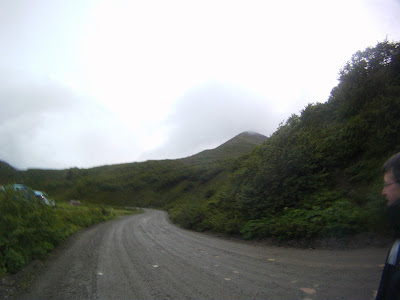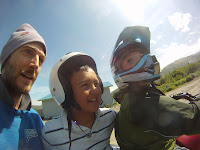Being back on a continental landmass, it felt appropriate to revert to train travel, and the Alaska Railroad was well-placed to acheive this. I managed to get a seat in the "Gold Class" section of the train, with its observation windows allowing us to see up to the tops of the mountains we passed through.
 |
| The curious shape of the observation glass leads to some interesting reflection effects |
A lot of the tourists on the train were reading magazines or playing cards or computer games - I couldn't think why, as I was enthralled by the jaw-dropping scenery ... glaciers, lakes, complicated river formations with multiple channels...
The train was well-staffed with a team who gave us a good running commentary on the terrain we were passing through, and pointed out wildlife when it appeared along the way. Another perk of the gold-class section was the ability to go outside to an open-air section where the roof was glass, but there were no side windows.
At an average of about 26 miles per hour, the train took us through the mountain wilderness that is the Kenai Peninsula, over and along a narrow rocky gorge, and then down into a wide open valley that led us back down to sea level.
Here we wound our way alongside a body of water called Turnagain arm: so-named because when Captain Cook was searching the area for a way through to the North-West Passage, he found that since it was yet another inlet he had to turn again and keep on searching.
We were warned that the mud flats that appear at low tide are treacherous as they look solid and may feel like concrete to walk on, but can instantly turn to quicksand as the water rises.
Coming into Anchorage, we passed crowds of young people waving to the train, and caught a rare glimpse of Denali, North America's highest point, just over the horizon.



















































